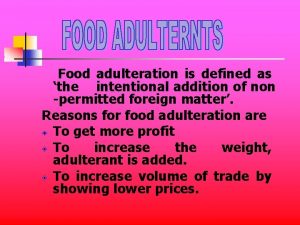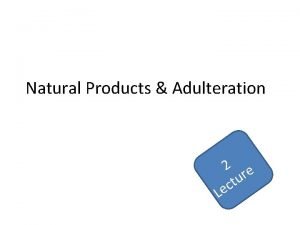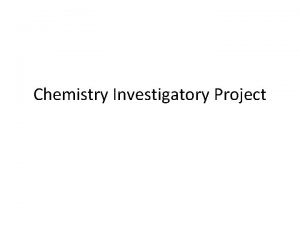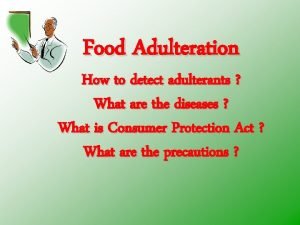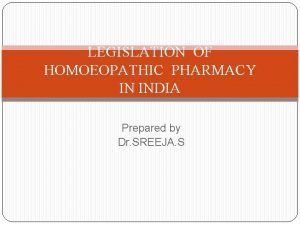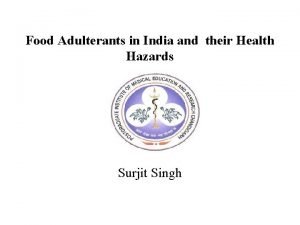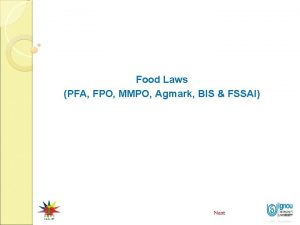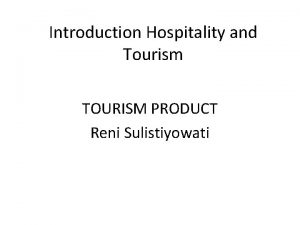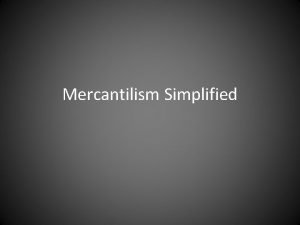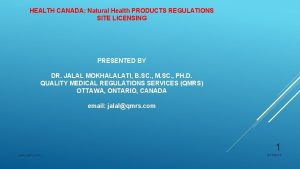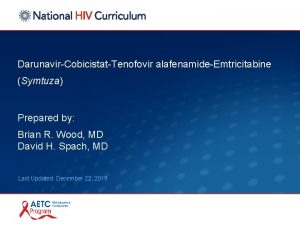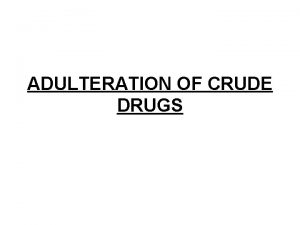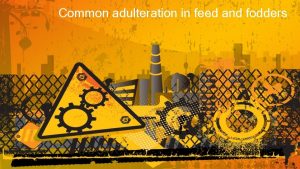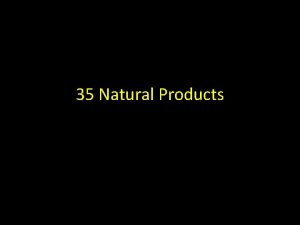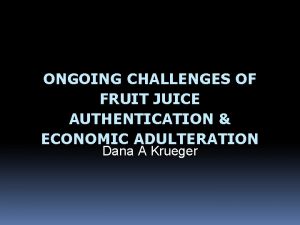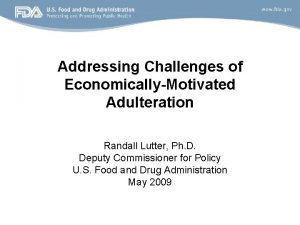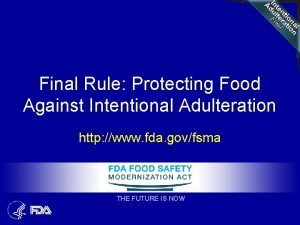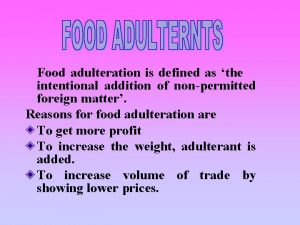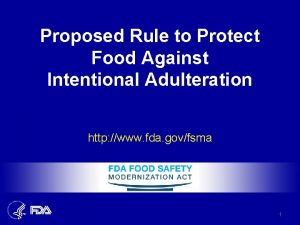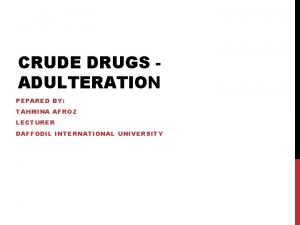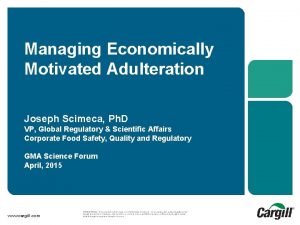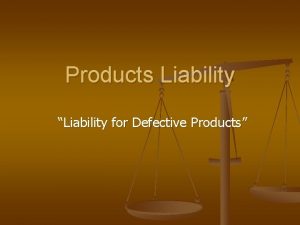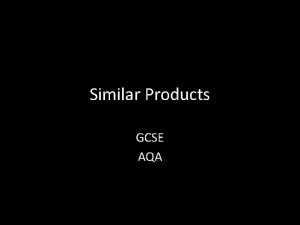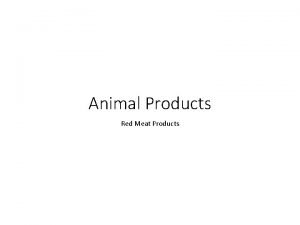Natural Products Adulteration L 2 e r u























- Slides: 23

Natural Products & Adulteration L 2 e r u t c e

Natural Product • A natural product is a pharmacologically or biologically active chemical compound , which is found in nature and produced by a living organism. • Natural products research focuses on the chemical properties, biosynthesis and biological functions of secondary metabolites. • Primary metabolites which are produced by primary metabolism. • The primary metabolites such as carbohydrates, proteins, fats, and nucleic acids, are essential for life and are commonly present in all organisms in large amounts. • Life cannot exist without primary metabolism.

• Secondary metabolites are those products of metabolism that are not essential for normal growth, development or reproduction of an organism. In this sense they are "secondary". Value of natural products Compounds from natural sources play four significant roles in modern medicine: 1. They provide a number of extremely useful drugs that are difficult, if not impossible, to produce commercially by synthetic means. 2. supply basic compounds that may be modified slightly to render them more effective or less toxic. 3. Their utility as prototypes or models for synthetic drugs possessing physiologic activities similar to the originals.

• 4. Some natural products contain compounds that demonstrate little or no activity themselves but which can be modified by chemical or biological methods to produce potent drugs not easily obtained by other methods • Baccatin III from Pacific yew tree (Taxus brevifolia) Baccatin III Taxol

Crude drug: A crude drug is naturally occurring drug with pharmacologically active ingredients in an unrefined state, requiring no additional processing for use. An example is ginseng root; patients can consume fresh or dried roots straight in addition to grinding them into powder for use in capsules, tea, and other preparations. The root is ready to use as it comes out of the ground, in contrast with other botanical pharmaceuticals that may require processing to extract useful compounds. Classification of Crude Drugs: A method of classification should be (a) Simple (b) Easy to use (c) Free from confusion and ambiguities.

1 -Alphabetical Classification Some of the pharmacopoeias, dictionaries and reference books which classify crude drugs according to this system are as follows. 1. Indian Pharmacopoeia 2. British Pharmacopoeia 3. British Herbal Pharmacopoeia 4. United States Pharmacopoeia and National Formulary 5. British Pharmaceutical Codex. 6. European Pharmacopoeia **In European Pharmacopoeia these arranged according to their names in Latin where in U. S. P. and B. P. C. , these arranged in English.

• Advantages: • 1 -Alphabetical classification is the simplest way of classification of any disconnected items. • 2 - It is easy and quick to use Examples: Acacia, Senna, Opium, Yellow bees wax. 2 - Morphological Classification: which part of the natural product is used as a drug. Woods– sandalwood / Leaves– Digitalis / Barks– Cinnamon/ Flowering parts– Chamomile/ Fruits– Tamarind/ Seeds– Bitter almond/ Roots and Rhizomes– Turmeric/ Plants and Herbs– Ephedra/Hair and Fibres– Cotton/ Dried latex– Opium/ Dried Juice– Aloe/ Waxes – Beeswax/Resins– Tolu balsam/ Volatile oil– Eucalyptus/ Fixed oils- Castor oil.

• Advantages: This system of classification is more convenient for practical study especially when the chemical nature of the drug is not clearly understood. • Disadvantages: 1. The main drawback of morphological classification is that there is no co-relation of chemical constituents with therapeutic actions. 2. Repetition of drugs or plants occurs. 3. Taxonomical Classification: Taxonomical classification is purely a botanical classification and is based on principles of natural relationship and evolutionary developments. They are grouped in Kingdom, phylum, order, family genus and species. Advantage: Taxonomical classification is helpful for studying evolutionary developments. Disadvantage: This system also does not co-relate in between the chemical constituents and biological activity of the drugs.

• Family: Cannabaceae • Genus: Cannabis • Species: sativa (Cannabis sativa) 4. Pharmacological Classification: This classification is more relevant and is mostly followed method.


Advantages: This system of classification can be used for suggesting substitutes of drugs if they are not available at a particular place or point of time. Disadvantages: Drugs having different action on the body gets classified separately in more than one group that causes ambiguity and confusion. Cinchona is antimalarial drug because of presence of quinine but can be put under the group of drug affecting heart because of antiarrythymic action of quinidine. 5. Chemical Classification: The crude drugs are divided into different groups according to the chemical nature of their most important constituent.

1. Carbohydrates– Carbohydrates are polyhydroxy aldehydes or ketones containing an unbroken chain of carbon atoms. Gums( Acacia, Guargum) Mucilages( Plantago seed ) Others (Starch, Honey, ) 2. Glycosides – Glycosides are compounds which upon hydrolysis give rise to one or more sugars (glycone) and non-sugar (aglycone). Anthraquinone Glycosides (Aloe, Senna ) Saponins Glycosides ( Glycyrrhiza ) Cyanophore Glycosides( Wild cherry bark) Isothiocyanate Glycosides (Mustard ) Cardiac Glycosides (Digitalis, ) Bitter Glycosides (Gentian, ) 3. Tannins– Tannins are complex organic, non-nitrogenous derivatives of polyhydroxy benzoic acids. Examples- Pale catechu, Black catechu

4. Volatile oils– Monoterpenes and sesquiterpenes obtained from plants Examples- Cinnamon, Cardamom, Orange peel, Mint, Clove. 5. Lipids Fixed oils – Castor, Olive, Shark liver oil Fats – Lanolin Waxes – Beeswax. 6. Resins– Complex mixture of compounds like resinols, resin acids, resinotannols, resenes. Examples Capsicum, Turmeric. 7. Protein – Gelatin. 8. Vitamins - Yeast 9. Triterpenes – Rasna.

10. Alkaloids – Nitrogenous substance of plant origin Pyridine and Piperidine – Nicotiana Tropane - Coca, Belladonna. Quinoline – Cinchona Isoquinoline – Opium. Indole – Ergot, Rauwolfia Amines – Ephedra Purine – Tea, coffee. advantages : It is a popular approach for phytochemical studies disadvantages: Ambiguities arise when particular drugs possess a number of compounds belonging to different groups of compounds.

6. Chemotaxonomic Classification: It is the latest system of classification and gives more scope for understanding the relationship between chemical constituents, their biosynthesis and their possible action. ADULTERATION: It is a process of substituting original crude drug partly or wholly with seemingly similar substances which are devoid of chemical entity or are inferior in their constituents and pharmacological property. Adulteration may takes place by two ways: - Direct or intentional adulteration - Indirect or unintentional adulteration

Types of Adulteration: 1. INFERIORITY ﺍﻟﺮﺩﺍﺀﺓ It is the condition in which substandard drug is produced naturally contain same active constituent but lesser in amount. 2. SPOILAGE ﺗﻠﻒ : It refers to a process in which the quality or value of crude drug has been so impaired and destroyed by action of fungi and bacteria as to render the drug unfit for human consumption. 3. SOPHISTICATION : ﻏﺶ ﻣﺘﻌﻤﺪ means addition of spurious ﻣﺰﻭﺭ or inferior material to an compound with an intent to defraud. 4. ADMIXTURE : ﺍﺧﺘﻼﻁ It refers to addition of one crude drug to another accidently or due to ignorance or carelessness. There is a limit for admixture and presence of admixture in quantities higher than establish limits results in adulteration.

5. DETERIORATION : ﺗﻠﻒ ﺗﺪﺭﻳﺠﻲ It refers to any impairment in the quality or value of a crude drug due to some physical processes e. g. distillation , extraction, aging, moisture, heat, resulting in destruction of its valuable constituents. The factors which must be considered in relation to drug deterioration are moisture content, temperature , light and the presence of oxygen. When these conditions are suitable, living organisms(bacteria, moulds, mites and insects)will rapidly multiply, using the drug as a source of nutrient. Drugs affected in this way are excluded by national pharmacopoeias. 6. SUBSTITUTION : It is a process in which such adulterants are used that resemble actual drug in morphology, chemical constituents and in some cases in therapeutic efficacy but substandard in nature and hence cheaper in cost e. g. Capsicum minimum is substituted with Capsicum annuum.

METHODS OF ADULTERATION 1. Substitution with substandard commercial varieties: Adulterants resemble the original crude drug morphologically, chemically, therapeutically but are substandard in nature and cheaper in cost. This is the most common type of adulteration. Indian senna is substituted with Arabian senna. 2. Substitution with Similar Inferior Drugs: Inferior drugs may or may not have any chemical or therapeutic value. They resemble only morphologically, so due to its resemblance they are used as adulterants. Bees wax is substituted with Japan wax

3. Substitution with Artificially Manufactured Substance: The drug is adulterated with the substance which has been prepared artificially. The artificially manufactured substance resembles the original drug. yellow coloured paraffin wax for bees wax are common examples. 4. Substitution with Exhausted (or deteriorated) Drug: The same drug is admixed but that drug is devoid of medicinally active substance as it has been extracted already. As it is devoid of colour and taste due to extraction, natural colour and taste is treated with additives.

5. Substitution with Synthetic Chemicals to Enhance Natural Character: Synthetic chemicals are used to enhance natural character of the exhausted drug. Examples: citral is added to citrus oils like lemon and orange oils(to add odour). 6. Presence of extra components of crude drug: Presence of extra components of crude drug with the authentic drug either because of their resembling colour, odor, or in some cases constituents. The stem portions are mixed along with leaf drugs like senna.

7. Addition of toxic principles: Some are harmful materials as the adulterant, are collected from market waste materials and admixed with the drug. It is done for the liquid drugs. White oil (insecticide spray in coconut oil). 8. Adulteration of Powders: The drugs which are in the form of powders are frequently adulterated. exhausted ginger in ginger.

Reasons of Adulteration • 1 Confusion in Vernacular Names: • 2 Lack of Knowledge About Authentic Source: • 3 Similarity in Morphology: • 4 Lack of Authentic Plant: • Hypericum perforatum is cultivated and sold in European markets. In India, availability of this species is very limited. However, the abundant Indo-Nepal species H. patulum, sold in the name of H. perforatum. • 5 Similarity in Color: • 6 Careless Collections:

Types of Substitution • 1 Using Totally Different Drug • 2 Substitution of the Species Belonging to Same Family. The Datura metel and Datura stramonium • 3 Using Different Species • 4 Using Different Parts of the Plant • 5 Due to Same Action
 Examples of functional and innovative products
Examples of functional and innovative products Pepsi 4ps marketing mix
Pepsi 4ps marketing mix Food adulteration summary
Food adulteration summary Food adulteration define
Food adulteration define Common food adulteration
Common food adulteration Hypericum adulteration red colorant
Hypericum adulteration red colorant Drug adulteration
Drug adulteration Adulteration of yellow lead salts to turmeric powder
Adulteration of yellow lead salts to turmeric powder Prevention of food adulteration
Prevention of food adulteration Drug adulteration
Drug adulteration Different methods of adulteration of crude drugs
Different methods of adulteration of crude drugs Adulteration of dal with kesari dal mainly causes
Adulteration of dal with kesari dal mainly causes Pfa standards for food
Pfa standards for food Food adulteration reaches new height
Food adulteration reaches new height Khawla natural products
Khawla natural products A business that moves goods from one business to another
A business that moves goods from one business to another What is natural tourism product
What is natural tourism product Unprocessed natural products
Unprocessed natural products Natural health product licensing canada
Natural health product licensing canada Natural hazards vs natural disasters
Natural hazards vs natural disasters Natural income
Natural income Aloe vera presentation
Aloe vera presentation Symtuza counterfeit products
Symtuza counterfeit products Products of france in pakistan
Products of france in pakistan



